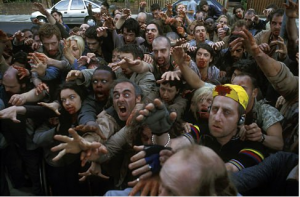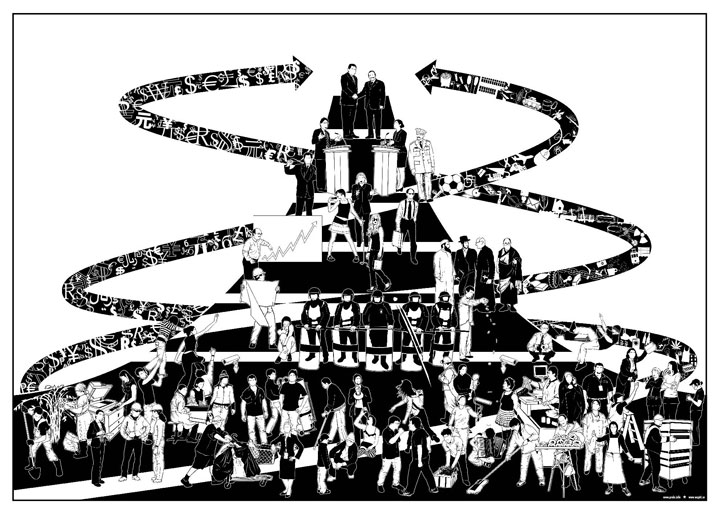As with most public policy issues, the American public is being fed a steady stream of untruths as part of the current debate over Obama’s health care initiatives. I’ve never understood the willingness of many Americans to take at face value the claims of politicians (and the mainstream media) who are so clearly controlled by corporate interests, but …
One of the main whipping boys in the current debate on health care policy in the United States is Canada’s health care system. US politicians and the media paint a picture of Canada’s “socialized” health care as bleak, gray queues of people lined up for months awaiting appointments with physicians not of their own choosing, for procedures that are inaccessible.
After living and working in Canada for six years there is no doubt in my mind that a single-payer health care system is better for individuals and society.
My family has had quick access to primary care physicians and specialists, short wait times in several visits to emergency rooms, and no co-pays. We have had family members and friends receive fast and high quality treatments for serious diseases over long periods of time, with no medical bills.
The Canadian system is not perfect, but unlike the U.S., where tens of millions of people have no or limited access to medical care (while the rich have unlimited access), the Canadian system values equal access to medical treatment for everyone.
Some Americans go to great lengths to deny the benefits of Canada’s universal health care, readily believing the lies that spew from the politicians and news media that serve the interests of US insurance and pharmaceutical industries. Take my sister, for example. She has never set foot in Canada, yet she argues with me about my own first-hand experiences with Canadian health care telling me that the “socialism” of Canadian medicine does not allow me to choose my own doctor, limits my access to care, and is run by a vast army of government bureaucrats hell bent on stamping out “freedom of choice.” There seems to be no room for the facts in the current debate on health care in the US, nevertheless I’ll offer up a few.
In the 1960s the US chose to provide health care for the elderly (Medicare) and poor (Medicaid), while Canada adopted universal coverage for hospital and physician services. All Canadians have insurance for hospital and physician services with no deductibles or co-pays. And most provinces provide care that goes beyond these areas to include home and long-term care, prescriptions and medical equipment, though there are co-pays for these coverages. Michael M. Rachlis, a Toronto physician and health policy analyst, has compared the results of these choices and identifies a number of lessons the US could learn from Canada on health care.
First, Rachlis notes that a single-payer system would eliminate most of the coverage problems in the US. The US spends 16% of its GDP on heath care compared to 10% in Canada—a difference of $800 billion which is almost entirely devoted to overhead costs instead of patient services. Rachlis points out that “Canadians don’t need thousands actuaries to set premiums or thousands of lawyers to deny care” and that US Medicare has up to 90% lower administrative costs than private health insurers.
Secondly, single-payer systems reduce duplication of administrative costs and allow lower prices to be neogtiated and, as a result of the difference in spending for non-patient care, Canadians actually get more services. Canadians see the doctor more often than Americans and take more drugs. Canadians have more lung transplants and get less heart surgery (but not so much less that they are more likely to die of heart attacks). Canadians live almost three years longer than Americans and their infant mortality is 20 per cent lower than in the US.
The bottom line according to Rachlis is that single-payer plans work because their funding goes to services not to overhead (and profits).
The Canadian system is not perfect, there are waits for elective care, and Rachlis notes that chronic disease management could be much improved. But, according to the Commonwealth Fund of New York has noted these are problems that Canada shares with the US.
The huge influence that drug and insurance companies weld over government is part of the explanation for why there is such resistance to universal health care among policy makers in the US.
But another piece of the puzzle is that most Americans are ignorant of what’s going on north of the border and thus more susceptible to being mislead by interests vested in the status quo. Rachlis points out that,
“The US media, legislators, and even presidents have claimed that our “socialized” system doesn’t let us choose our own doctors. In fact, Canadians have free choice of physicians. It’s Americans these days who are restricted to “in plan” doctors.
To top it all off, a recent study by Canadian Centre for Policy Alternatives—Canada’s Quiet Bargain: The benefits from public spending – pdf—indicates that the majority of Canadians enjoy a higher quality of life because public services funded by their taxes come at a solid bargain.
The study concludes that an average middle-income family in Canada would have to spend more than half its pay check to buy health care, education and the other ‘free’ public services now paid for with tax dollars. The study shows middle‐income Canadian families enjoy public services worth about $41,000—or 63% of their income. Even households earning $80,000-$90,000 a year enjoy public services benefits equivalent to about half of their income. Yet another lesson to be learned, if the US was willing to pay attention to what goes on north of the border.
 Follow
Follow



